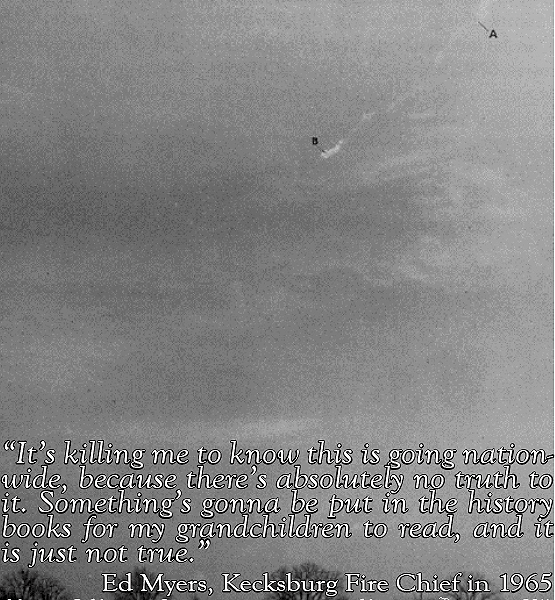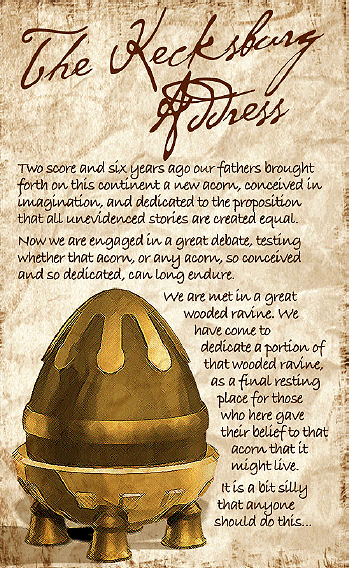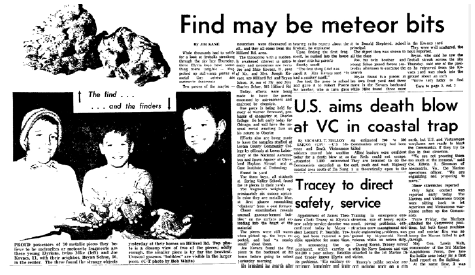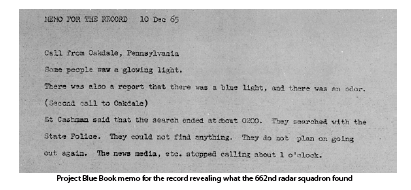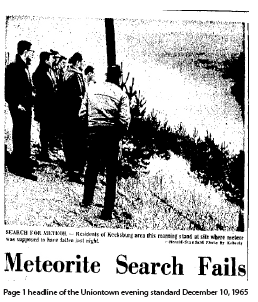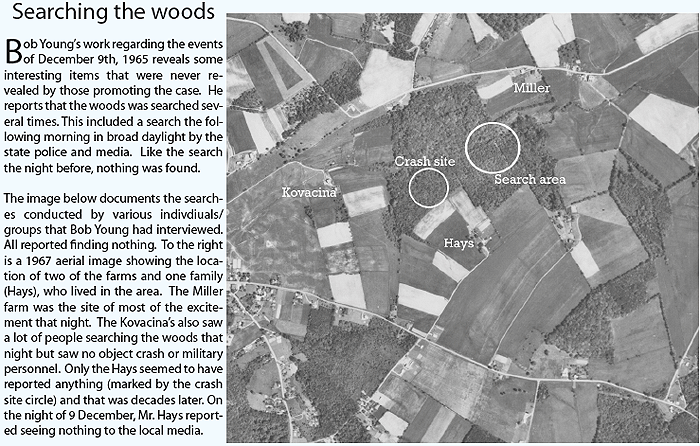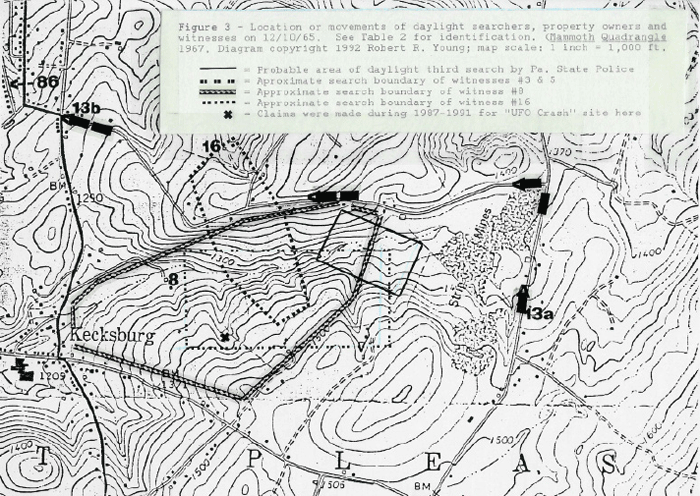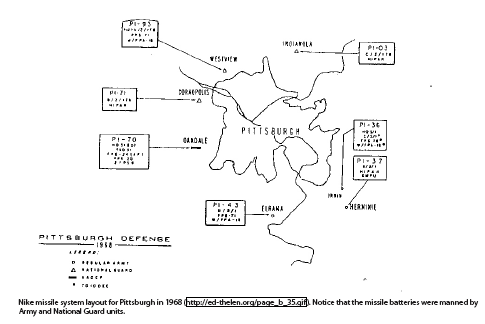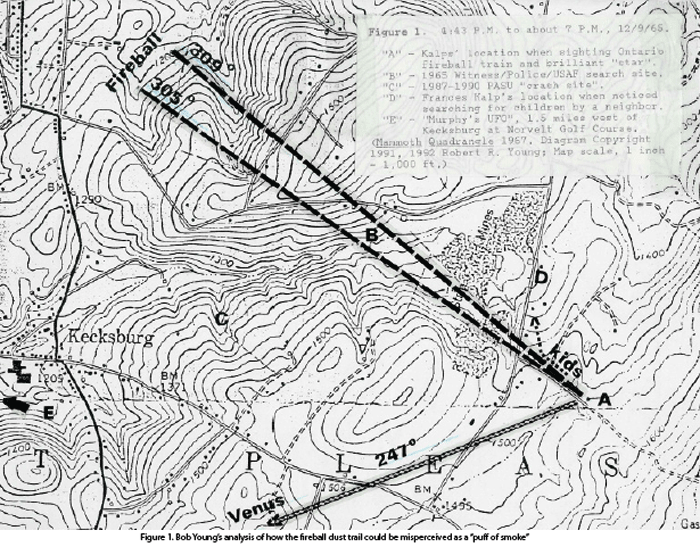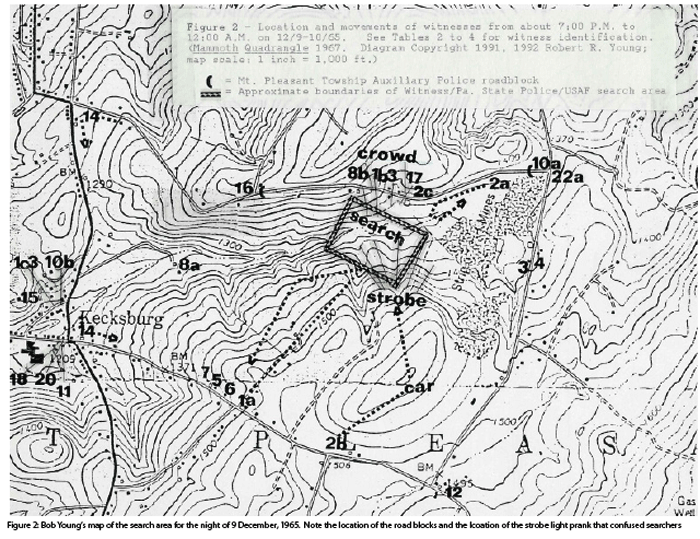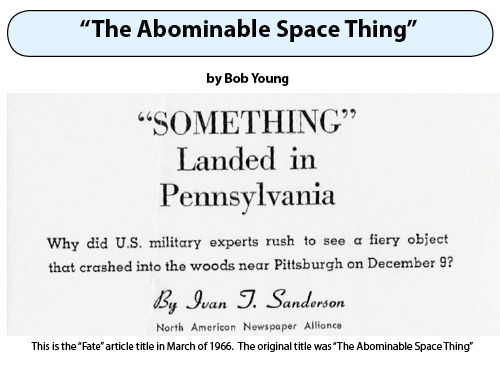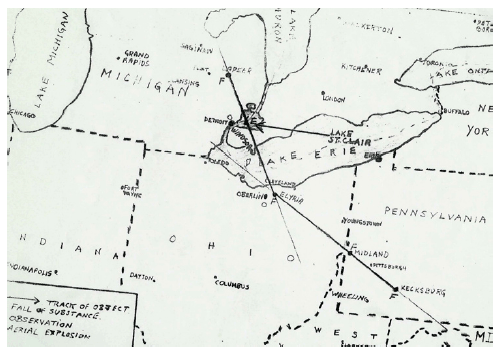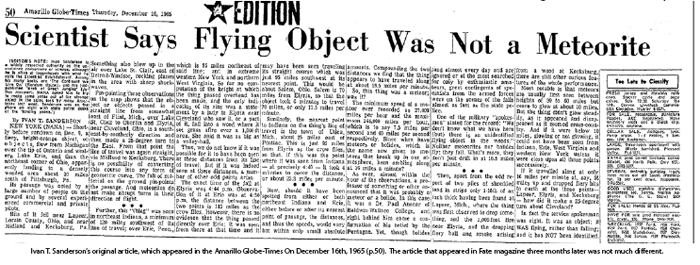This change of direction by the object seems to have first been proposed only three days after the event by Sanderson, a UFO and cyptozoological writer, in his manuscript submitted to the North American Newspaper Alliance. It was published in many newspapers, then reprinted in Fate magazine. For decades UFO fans seeking to vicariously relive the thrills experienced by witnesses or just redredging up old reports have started at the beginning of many saucer stories, managing only to prolong old myths and long-solved mysteries.
Sanderson drew lines between witness locations where the object was first reported to have dropped material to the ground (Lapeer, Michigan; Lorain County, Ohio; Midland, PA, and Kecksburg), believing that this “automatically pinpointed] the passage”. Nothing actually seems to have been found at Midland and there is no reason to think that Lorain fragments, or aircraft foil picked up at Lapeer were associated with the meteor. Since many other reported “landing locations” were not included by Sanderson, this early
theory cannot be supported by what is now known. One example is a widely reported sighting from Erie, (9) where witnesses say the fireball disappear at the western horizon over the lake. Notes in the Blue Book files even report Air Force investigators going there. Why wasn’t this “location” used by Sanderson? We’ll never know. Playing “connect the dots” of witness locations on a map for an object visible for hundreds of miles does not prove maneuvering.
If Sanderson had drawn a line on a real map, as I did6, instead of using a hand-drawn sketch1 or if later UFO crash enthusiasts had made even the most elementary check of his claim instead of repeating his method(3,7,8) they would have noticed flaws in his story. They would have seen that a path from Lapeer, Michigan, to Elyria, Ohio, would be at an azimuth of 152 degrees, and from Elyria to Kecksburg would be at an azimuth of 120 degrees, a difference of 32 degrees, not 25 degrees as Sanderson claimed. An object using Sanderson’s path would pass no closer than 26 miles to the south of Kecksburg
.
His speeds were also grossly in error, referring to miles/hour when the calculations clearly referred to miles/minute. This represents a 60 times error in speed, allowing fantastic speculations about a maneuvering saucer to excite enthusiasts for years. Even with original witness reports and their scatted times, a rational analysis would have cast doubt on Sanderson’s claims.
Western Pennsylvania UFO researcher Stan Gordon claimed in the 1990 “Unsolved Mysteries” show which kicked off national interest in the incident, that the object seem by thousands over the Midwest about 4:45 PM changed direction, then travelled for ten minutes before maneuvering and “crashing” near Kecksburg.
This can be refuted by the fact that no local 1965 witnesses reported seeing two objects, the fireball in the western sky and then later the maneuvering UFO nearby.
However, I must tell you that a few months after I first presented this argument against a “slow” moving UFO, back in the early 1990’s, one of the newly surfaced witnesses central to the later crash and recovery story suddenly began claiming the UFO actually circled the town. To this day, he is the only person to have claimed to notice this spectacular maneuvering. I’ll let you, dear reader, draw your own conclusions.
The wide range of times for reports is probably due to the usual wide range of eyewitness “details” one gets from fireball reports. Clocks and watches are set at different
times and many just estimate the times of such events. The many reports from airplane pilots collected by the FAA, and a seismic recording in Michigan allowed
the actual time to be determined to within a few seconds.
Many of the original published times ranged from 4:40 to “about 5:15”. The key Kecksburg witness, Mrs. Kalp, reported the time as 4:45 P.M. in the local Greensburg paper10, only one minute later than a 4:44 P.M. report from Oberlin, Ohio, carried in the Pittsburgh Press11. This distance - 180 miles in one minute - would give a hypothetical
speed of about 10,800 miles per hour, well within the speeds of meteors in the lower atmosphere or reentering space debris, which would have been visible
throughout the sighting area. Why didn’t the UFO investigators cite this speed? Was it because it would support the official cause of a meteor?
Proponents of a maneuvering UFO must explain how every 1965 Pennsylvania witness missed seeing a fireball brighter than the full moon at 4:44 P.M. low in the west, but only saw the UFO “maneuvering” nearby at about this same time. This includes three independent witnesses (all facing west) in Beaver County, Pa., about 60 miles northwest of Kecksburg. They must also explain how the accounts of every 1965 witness for which a direction is known or can be inferred can be explained by assuming they were watching the fireball over Lake Erie low in the western sky. Without an explanation for these curious coincidences between witness reports at Kecksburg and everywhere else, any theory of maneuvered flight can’t satisfy the facts.
Mr. Gordon and fellow promoters of a crash as Kecksburg also must explain why three independent witnesses at Midland, Pa., (all facing west) also missed the fireball,
and why they and Mrs. Kalp mistakenly thought the UFO appeared at 4:45 P.M., when hundreds of others first saw it as a fireball visible from hundreds of miles away. Without an explanation for these occurrences, the maneuvering UFO theory falls flat.
How an unexpected event lasting a few seconds can transmogrify into a 10-minute maneuvering saucer circling a town is truly a wonder of Ufology. It is, however, nothing new to astronomers trying to filter through reports of bright fireball meteors.
Ivan Sanderson was the source of the erroneous notion that the object maneuvered, and therefore could not be a meteor. He seems to have spoken to no eyewitnesses, relying on wire service stories and phone calls to state police spokesmen. His hand-sketched map was inaccurate and his “speeds” were grossly in error. Any present day UFO enthusiast
who still cites his hastily written and inaccurate but widely reprinted article only demonstrates that old saucer tales seldom die.
Notes and references
National Investigations Committee 1. on Aerial Phenomenon (NICAP) files: Courtesy of Mark Rodeghier, J. Allen Hynek Center for UFO Studies; personal communication, Feb. 23, 1991.
Hartmann, William K. Process of Per2.
ception, Conception and Reporting, Table 4 in Scientific Study of Unidentified
Flying Objects, Edward U. Condon,
et. al.: Bantam Books, New York, Jan. 1969: p 588
“Unsolved Mysteries”, NBC, Sept. 19, 3. 1990 and Feb. 27, 1991.
Gordon, Stan. The Kecksburg UFO 4. Crash: An Interim Report, MUFON UFO Journal, No. 274, Feb. 1991, p. 3-5. Copyright 1991 by the Mutual UFO Network, 103 Oldtowne Rd., Seguin, Texas 78155.
Sanderson, Ivan T. Something Land5.
ed in Pennsylvania, North American Newspaper Alliance, reprinted in Fate, March, 1966.
“Lake Erie”, International Map of the 6. World. Reston, Va.: USGS, 1974.
Gordon, Stan. The Military UFO Re7.
trieval at Kecksburg, Pennsylvania, Pursuit, No. 174, last quarter, 1987. Courtesy of George W. Earley.
Gordon, Stan, “The Kecksburg UFO 8. Crash”, MUFON Journal, Sept., 1989, Copyright 1989 Mutual UFO Network,
103 Oldtowne Rd., Seguin, Tx
The Erie (Pa.) Daily Times, Fireball 9. Over Erie Remains a Mystery, Dec. 10, 1965, p. 1.
The Tribune-Review (Greensburg, 10. Pa.), Searchers fail to find object, (late City Edition), Dec. 10, 1965, p. 1.
Pittsburgh Press, Fireball a Meteor, 11. Astronomer Explains, Dec. 10, 1965, p. 1.
.
Two investigations with two very different results
.
In December 1965, two types of investigations were made into the events that transpired the night of December 9th. Each wanted to determine where the remains of the object that was seen came down. Each employed different methodologies, which produced two completely different results.
Eureka in just 7 days!
In less than one week, Ivan T. Sanderson had made his conclusion. The event involved an “unidentified” object (or “thing” as he described it) that had moved at an average speed of 16.5 miles per minute (about 1000 mph). Not only did the object move at too slow a speed, Sanderson also noted that the object changed direction during its flight. Both of these factors, if correct, ruled out the meteor explanation.
Sanderson achieved his quick success by making phone calls to various police departments and reading the news accounts. While this was a good start to an investigation, it was essentially the limit to Sanderson’s research in his article. It resulted in serious flaws in his conclusions.
Bob Young’s article on the previous pages pokes all the holes in Sanderson’s effort and I see no need to repeat them. However, because of some very incorrect assumptions,
Sanderson’s calculations and trajectory were open to error. He rushed to publish his story and ignored a lot of data. As one will see, a far greater weight of the witness testimony would indicate a completed different trajectory that was consistent with the meteor explanation.
As the professor went further west, along the southern and western coast of Lake Erie, he determined that the meteor did not make it to the southern end of the lake and that a sonic boom had been heard on the western half of the lake. Based on his interviews and description, Sky and Telescope listed the trajectory as going from roughly NW to SE over the lake. This preliminary trajectory would later turn out to be slightly off in its direction but fairly accurate in determining the general location of the meteor’s path.
All the claims of fragments being found were discovered to be “meteor-wrongs” and not meteorites. Additionally, observations by witnesses regarding the meteors distance were often inaccurate:
These imagined happenings arose from the impossibility of estimating the distance to an object in the sky. Almost everyone who saw the fireball thought it was much closer than it really was. When it had disappeared behind a house or a tree, many people thought it had fallen only a few hundred yards beyond. 1
The most important thing that Dr. Wetherill noted was that the meteor disappeared over Lake Erie and did not make it to the south side of the lake. The witness reports had demolished that part of Sanderson’s trajectory. However, further investigation and hard data would establish once and for all, that the meteor did not head towards Kecksburg.
.
Initial scientific investigation While Sanderson was trying to create his trajectory for the “thing”, scientists employed a more methodical approach in trying to locate any debris from the bright fireball.
G.W. Wetherill, a geophysics and geology professor at UCLA, just happened to be in the area at the time. His effort was documented in the February 1966 edition of Sky and Telescope. It is important to note that this issue was published shortly after the event. In the 1960s, magazines such as Sky and Telescope usually were completed and ready for printing several weeks before the date they were published. So, the article was written no later than about a month after the event in mid-January. Like Sanderson’s article, it was incomplete and missing important information that would later be revealed.
Dr. Wetherill started his investigation on 12 December by renting a car from Cleveland and visiting all the areas mentioned by the local media. The local FAA office was very helpful and they had reports from 23 pilots. Many of them thought a plane had come down in Lake Erie. Wetherill plotted the sight lines and determined that the meteor was seen over Lake Erie between Toledo, Ohio and Pelee island.
.
Better data = Better results
It was fortunate that two photographers, Lowell Wright and Richard Champine, were able to photograph the debris trail in the evening sky after the event. This debris trail provided a source of data that was accurate enough to compute a good trajectory.
.
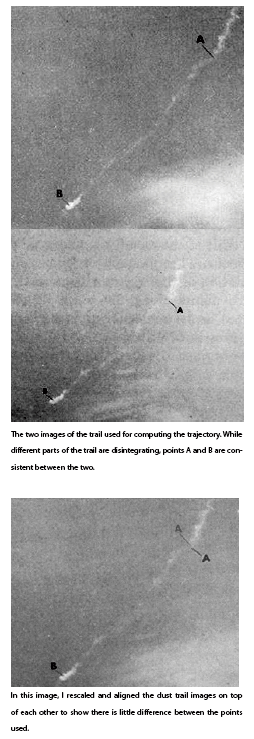
Dr. Von Del Chamberlain and Dr. David Krause would mention something that was very important:
The four Champine photographs cover a span of about 80 seconds, and reveal the total drift of the cloud was minimal. Although disintegration of the train is evident.2
Because of this, the scientists were able to select two distinct points on the debris trail (see above labeled A and B) and use them to compute a trajectory. Writing in the Meteorites of Michigan, Dr. Von Del Chamberlain (staff astronomer of the Abrams Planetarium in Lansing, Michigan) described what was done next:
The author and two associates, David Krause and Ralph Johnson, went to both these locations and made transit readings based upon the photographs. The trajectory and end-point of the fireball were then computed (fig. 4). Interviewing residents near the computed end-point revealed the fireball trail did, in fact, end directly overhead in extreme southwest Ontario, thus confirming its trajectory and likely region of fall. 3
Luckily both sets of photographs had landmarks, which allowed for pinpointing the location of the photographer and the trails position in the sky. The use of a transit allowed for precise measurements of azimuth and elevation. The resultant trajectory showed the meteor had appeared near the northern shore of Lake Erie and headed northeast.
.
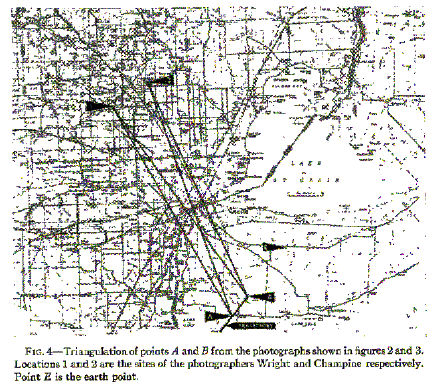
This was consistent with most of the witness reports that were being collected. Dr. Wetherill had collected some reports but Von Del Chamberlain in conjunction with Dr. J.A.V. Douglas and Henry Lee of the Royal Astronomical Society of Windsor had collected close to one hundred reports from which to refine the data. Not only did they have the reports but they conducted many of their interviews with the witnesses “on the spot” in order to refine the observational data.
On-the-spot interviews of some seventy observers (now close to 100)were made by Mr. Henry Lee, President of the Windsor Centre of the RASC, and the writer during part of January. Reduction of this sighting data confirmed the general ground position of the end-point as was determined from the photographs by Mr. Chamberlain.4
More confirmation of the trajectory came from seismic data recorded by the University of Michigan Geophysics lab near Ypsilanti, Michigan. It was the only seismograph
in the area that recorded the sonic event indicating that the terminal burst point was in the vicinity of the seismograph.
Seismographs in Ohio and Pennsylvania recorded nothing. If Sanderson’s plot towards Kecksburg were correct, then the seismographs in those regions would have recorded the terminal burst and the University of Michigan seismograph would not have.
All the data indicates the fireball’s trajectory ended up on the northern shore of Lake Erie and did not end near Kecksburg.
Ivan Sanderson’s flawed analysis had been easily refuted by science....or was it?
.
Trying to resurrect Sanderson
Over the years, UFOlogists have trumpeted Sanderson’s trajectory as a definitive work of some kind. This changed when Robert Young produced the analysis by Von Del Chamberlain and Krause. Still there were some “UFOcrashologists” that decided that Sanderson must have been right in a desire to believe in a Kecksburg crash. David Rudiak took up the challenge and published a critique and counter-analysis on his web site and can be found at http://www.roswellproof.com/Kecksburg_triangulation_error.html.
On his web page, Rudiak spends a great deal of space explaining why the astronomers were probably wrong in their analysis.
His argument is essentially based on three major points:
That there is no error analysis and 1. that a potential error in computing the azimuth and elevation could shift the computed path towards Kecksburg.
That Chamberlain and Krause failed 2. to notice or, apparently, lied about the “drift” caused by the winds between the Wright and Champine photographs. This drift could be the source of errors in their computations that would lead to a faulty solution.
That the apparent angular size of the 3. dust train was not uniform across the length of the trail indicating the debris trail pointed away from the photographers and towards Kecksburg.
Rudiak’s error is interesting because what he apparently wants is there to be some error in favor of a Kecksburg trajectory. He suggests potential errors in aligning the photographs with the local terrain. Ignored or unknown by Rudiak is the fact that a transit was used at the scene of the photographs and photographs carefully examined. Considering the fact that the differences between points A and B are only 5-6 degrees in azimuth, any error beyond a fraction of a degree would have been significant and obvious. Despite proclaiming an error could shift the trajectory towards Kecksburg, Rudiak does not even demonstrate that such an error even exists! For it to fit the Kecksburg
scenario, he has to have conditions just right and ignore all the supporting eyewitness reports gathered by Von Del Chamberlain, Krause, and Davis.
In his second major point, Rudiak makes a big deal about being able to measure drift due to high altitude winds and questioning the statements by Chamberlain and Krause that minimal drift was visible in the photographs. Rudiak’s “major drift” has nothing to do with points A and B, which were used for the trajectory computation, but to the rest of the components of the trail. Chamberlain and Krause noted this disintegration in their paper but also mentioned that Champine took four photographs over a period of 80 seconds, which showed no significant displacement for the key points A and B. These two points were the only parts of the trail that were used for computing the trajectory so any disintegration/drift of those sections would have no bearing on the results.
Rudiak’s third argument about the angular size across the length of the trail is faulty because it apparently assumes a constant width of the debris trail. It does not take into account how the dust trail was formed. Unlike bright fireballs at night, which leave trails of ionized atmospheric molecules that glow, the only trails left by daylight fireballs are due to the debris left behind by the meteoroid’s passage. As the meteoroid travels into the atmosphere, it’s dimensions and shape vary and, as a result, the amount of debris left behind varies. One can just as reasonably argue that the any change in the dust trail’s dimensions has more to do with the meteoroid’s interaction with the atmosphere than with a change in perspective.
Chamberlain and Krause were much more thorough in their analysis of the event than Rudiak suggests in his argument.
Rudiak implies the astronomers were working in a vacuum and relied solely on the photographs, which is not the case. They interviewed tens of witnesses and performed on the spot interviews to refine the data. They were interested in computing where any fragments had fallen. They would have checked for errors in their calculations if the witness testimony indicated a different path. According to Dr. Douglas, this was not the case.
When I first read David Rudiak’s work, I contacted Dr. Von Del Chamberlain mentioning this critique. His observation of Rudiak’s analysis was that he ignored all the scientific data gathered by hard work and investigation that confirmed the triangulation from the photographs. Von Del Chamberlain also suggested that David Rudiak was just trying to “prove” what he wanted to believe and ignored the confirmation by eyewitness reports and seismographic data. The bottom line is that he saw no reason to change the conclusions of his paper based on Rudiak’s speculation/belief in a spaceship crash at Kecksburg.
To top it all off, while apparently rejecting the work published in a scientific journal, Mr. Rudiak seemed perfectly willing to accept the self-published conclusions of Sanderson and the decades old recollections by eyewitnesses dug up by Stan Gordon. Can this be considered a reasonable scientific approach? It sounds more like pseudoscience, which is no substitute for the real scientific work that was done in 1965-66.
Notes and references
“The Great Lakes fireball”. 1. Sky and Telescope. February 1966. P79,82
Chamberlain, Von Del and David J. 2. Krause. “The fireball of December 9, 1965 - Part I”. Royal Astronomical Society
of Canada Journal 61.p. 188
Chamberlain, Von Del. 3. Bulletin 5: Meteorites
of Michigan. Michigan Department
of Conservation. Speaker-Hines and Thomas, Inc. Lansing, MI 1968. p. 5
Douglas, J. A. V. . “The fireball of De4.
cember 9, 1965, Essex County, Ontario”.
Proceedings of the Tenth Meeting of the Associate Committee on Meteorites.
Appendix 1. Council Chambers
of the National Research Laboratories,
Ottawa. 18 April 1966.
.
Quelle: SUNlite 6/2011
